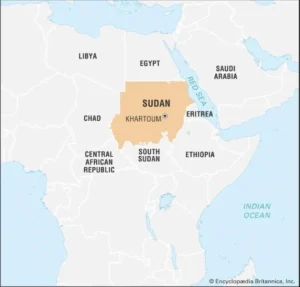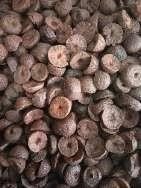GS Paper 2
Dafur
News: UN agencies warn of imminent starvation risk in Sudan’s Darfur region.
Darfur:
- It is a region in northwest Sudan.
- Sudan has been embroiled in a long-standing civil war between Arab and African communities.
- The conflict has resulted in widespread violence and numerous human rights abuses, exacerbating tensions and instability in the region.

Sudan: It is a country located in northeastern Africa.
- Sudan’s capital, Khartoum, is located roughly in the centre of the country.
- Sudan is bounded on the north by Egypt, on the east by the Red Sea, Eritrea, and Ethiopia, on the south by South Sudan, on the west by the Central African Republic and Chad, and on the northwest by Libya.
- Sudan is mainly composed of vast plains and plateaus that are drained by the Nile River and its tributaries.
- Sudan has Dinder National Park and Radom National Park, in the southwest, have been designated as UNESCO biosphere reserves.
- The country is dominated by Muslims, most of whom speak Arabic and identify themselves as “Arabs.”
GS Paper 3
Choline
News: Researchers have discovered that choline, an essential nutrient vital for brain health, is actively transported from the bloodstream into the brain by a protein.
Choline: Choline is an essential nutrient vital for numerous bodily functions, encompassing cellular growth and metabolism. It exists in both water-soluble and fat-soluble forms, with the body handling and absorbing it differently based on its molecular structure.
Cell Structure:
- Choline serves as a crucial component within a significant category of lipids known as phospholipids, such as lecithin.
- These phospholipids constitute essential structural elements of cell membranes.
- Consequently, the presence of choline is indispensable for maintaining the structural integrity of all plant and animal cells.
Sources of Choline:
- While the body can produce small amounts of choline in the liver, it’s insufficient to meet daily requirements.
- Thus, obtaining choline from dietary sources is crucial.
- Rich sources include beef, liver, fish, dairy, soybeans, nuts, and eggs. Additionally, many fruits, vegetables, and whole grains contain choline.
Functions of Choline: Choline plays a pivotal role in various bodily functions:
- Cellular Health: It contributes to cell membrane structure and signaling, particularly vital for the nervous system.
- Metabolism: Choline aids in fat transport and metabolism, serving as nourishment for beneficial gut bacteria.
- Liver Function: Essential for maintaining liver health, it facilitates the clearance of cholesterol from the liver.
- Brain Development: Often referred to as a “brain nutrient,” choline is crucial for brain development and function.
- Pregnancy: Choline is integral for ensuring a healthy pregnancy.
Consequences of Choline Deficiency:
- Inadequate choline intake can lead to various health conditions, including cardiovascular disease, muscular damage, and problems with memory and learning.
- Thus, maintaining adequate choline levels is essential for overall well-being.
Orangutans
News: Malaysia has said it plans to start an “orangutan diplomacy” programme for countries that buy its palm oil.
Orangutans:
- Orangutans, recognized for their distinctive red fur, hold the distinction of being the largest arboreal animals.
- They spend approximately 90% of their waking hours in tree habitats.
- They primarily inhabit the rainforests of Borneo and Sumatra in Indonesia.

Unique Physical Traits:
- One of the distinctive physical attributes of orangutans is their long arms, capable of spanning up to 7 feet (2.1 meters).
- This adaptation facilitates their adept navigation and movement through the forest canopy.
Innovative Behavior: Medicinal Plant Use
- In a groundbreaking observation, an orangutan was documented utilizing a medicinal plant to treat a wound, showcasing their remarkable adaptability and resourcefulness in their environment.
Intelligence and Behavior:
- Orangutans are renowned for their intelligence, demonstrated through their adept use of tools and problem-solving skills.
- Remarkably, they share 96.4% of their genes with humans.
- Additionally, they exhibit highly social behaviors, living in small groups led by female leaders.
Dietary Habits:
- As frugivores, orangutans primarily subsist on a diet of fruits.
- However, they also consume leaves, flowers, insects, bark, and bird eggs to supplement their nutritional needs.
IUCN Conservation Status: Critically Endangered
Orangutan Diplomacy:
- Malaysia is the world’s second biggest producer of the edible oil after Indonesia.
- The rapid growth of palm oil industry has led to widespread deforestation, particularly in biodiversity hotspots of Malaysia, resulting in the destruction of critical habitats for endangered orangutans and other iconic species.
- Malaysia will offer orangutans as gifts to its major palm oil trading partners such as the EU, India and China, as part of the Orangutan Diplomacy.
- This will prove to the global community that Malaysia is committed to biodiversity conservation and a sustainable oil palm producer.
Note:
- Orangutan programme was inspired by China’s panda diplomacy.
- Beijing, which operates a giant panda breeding programme, generally loans pandas for 10 years providing the countries meet certain conditions for their care.
Arecanut
News: Arecanut cultivated in the Tirthahalli region has been identified as the highest quality variety among all those grown in Karnataka.
Arecanut: Known by various names such as Areca palm, yellow palm, or butterfly palm, the arecanut palm is renowned as the source of the popular chewing nut (betel nut or Supari).

Production and Distribution:
- India holds the dual distinction of being the largest producer and consumer of arecanut.
- The major producing states include Karnataka (40%), Kerala (25%), Assam (20%), along with significant contributions from Tamil Nadu, Meghalaya, and West Bengal.
Grading Process:
- Arecanut kernels undergo a grading process wherein they are boiled, and areca precipitates are added post husk removal.
- Subsequently, the nuts are dried and sorted into various grades like Nuli, Hasa, Rashi, Bette, and Gorabalu based on their market value.
Favorable Agroclimatic Conditions:
- Climate: Arecanut cultivation thrives within a specific climatic range, typically confined to regions approximately 28º north and south of the equator.
- Optimal growth occurs within temperatures ranging from 14ºC to 36ºC, with adverse effects observed below 10ºC and above 40ºC.
Soil:
- The crop predominantly flourishes in gravelly laterite soils of the red clay type, with fertile clay loam soils also supporting growth.
- Unsuitable soil types include sticky clay, sandy, alluvial, brackish, and calcareous soils.
Rainfall and Irrigation:
- Arecanut cultivation necessitates an ideal rainfall range of 750 mm to 4500 mm, supplemented by irrigation where necessary.
Seasonality:
- Optimal growing conditions are observed from June to December, aligning with the seasonal calendar for arecanut cultivation.
Alternative Investment Funds (AIFs): Concepts, Categories and Benefits | UPSC
Tactical Nuclear Weapon (TNW)
News: Russia will hold tactical nuclear weapon drills.
Definition and Classification: TNWs are weapons not classified as “strategic” under US-Russian arms control agreements like the Strategic Arms Reduction Treaty.
Purpose and Design: These weapons are smaller and lower-yield nuclear devices tailored for battlefield use against military targets or troop concentrations.
Distinguishing Characteristics: TNWs are differentiated from strategic nuclear weapons by their smaller size and intended use, as they are not meant for the large-scale destruction of cities or industrial centers.
Operational Range: TNWs have a limited range, typically spanning a few hundred kilometers (approximately 500-600 kms), in contrast to the thousands of kilometers covered by strategic weapons.
Delivery Mechanisms: TNWs can be delivered through various means including aircraft, missiles, artillery, or even landmines.
West Nile Fever
News: West Nile Fever cases reported in Kerala.
Definition: West Nile Fever is a viral infection transmitted primarily by mosquitoes, caused by the West Nile virus (WNV).
West Nile Virus (WNV):
- The West Nile Virus (WNV) is a mosquito-borne, single-stranded RNA virus.
- It is a flavivirus and is related to the viruses that cause Japanese encephalitis and yellow fever.
Spread:
- Vector Transmission: Culex species of mosquitoes serve as the primary vectors for transmitting West Nile Virus (WNV) to humans and animals.
- Transmission Cycle: Infected mosquitoes transmit the virus to humans and animals, including birds, which act as reservoir hosts for the virus.
- Mosquito Infection: Mosquitoes become infected with WNV when they feed on infected birds, which carry the virus in their bloodstream for a brief period.
- Viral Migration: Over time, the virus migrates to the mosquito’s salivary glands, facilitating its transmission during subsequent blood meals when mosquitoes bite humans and animals.
- Alternative Transmission Routes: WNV can also be transmitted through blood transfusions, from an infected mother to her child, or through exposure in laboratory settings.
-
- However, there is no evidence of transmission through casual contact with infected individuals or animals.
-
- Incubation Period: Ranges from 2 to 6 days, extending up to 14 days, and possibly longer in immunocompromised individuals.
-
- Human-to-human transmission through casual contact has not been documented to date.
-
Symptoms: The disease is asymptomatic in 80% of the infected people. For rest, the symptoms include fever, headache, fatigue, body aches, nausea, rash, and swollen glands.
- It usually turns fatal in persons with comorbidities and immuno-compromised persons (such as transplant patients).
- Death rate is relatively low compared to Japanese encephalitis, which shows similar symptoms.
Treatment:
- No WNV-specific prophylaxis, treatment or vaccine is available.
- Only supportive treatments are given to neuroinvasive WNV patients.
Why is it called West Nile Virus?
- The virus was first isolated in a woman in the West Nile district of Uganda in 1937.
- It was identified in birds (crows and columbiformes like doves and pigeons) in the Nile delta region in 1953.
- WNV outbreak sites are found along major bird migratory routes. The virus is found commonly in Africa, Europe, the Middle East, North America, and West Asia.
Spektr-Rentgen- Gamma (Spektr-RG, SRG)
News: Astronomers report the discovery of a new pulsar using the Spektr-RG space observatory.
Definition: Spektr-Rentgen- Gamma (Spektr-RG, SRG) is a space astrophysical observatory to study the Universe in the X-ray range of electromagnetic radiation.
Mission Overview:
- The German-Russian high-energy astrophysics space observatory aims to explore the universe using X-ray electromagnetic radiation.
- X-rays facilitate the observation of celestial objects that are too hot or faint to be seen in visible light, including black holes, neutron stars, and hot gas in galaxies.
Purpose and Replacement: Designed to replace the Spektr-R, known as the “Russian Hubble,” which was launched in 2011 to study black holes, neutron stars, and magnetic fields.
Launch and Location:
- It was launched on July 13, 2019, from Baikonur, Kazakhstan.
- The observatory orbits the Sun at the second Lagrange point (L2), situated approximately 1.5 million kilometers away from Earth.
-
- L2 is a position in space where the gravitational forces of two massive objects, like the Sun and Earth, balance the centrifugal force acting on a smaller object.
-
Instruments: The observatory bears two unique X-ray mirror telescopes:
- ART-XC (Russia): Provides high-resolution imaging of X-ray sources.
- eROSITA (Germany): Offers a wider field of view to survey large areas of the sky.
Facts for Prelims
World Migration Report 2024
News: World Migration Report 2024 has been released by International Organization for Migration (IOM).
World Migration Report: It is published by International Organization for Migration (IOM) in every two years.
- This report reveals significant shifts in global migration patterns, including a record number of displaced people and a major increase in international remittances.
Key Findings of the Report:
Global Migration Statistics:
- There are 281 million international migrants worldwide, constituting 3.6% of the global population.
- In 2022, there were 117 million displaced individuals globally, with 71.2 million being internally displaced.
Drivers of Displacement:
- Displacement is primarily fueled by factors such as conflict, political or economic instability, and climate change.
| Rank | Country (2020) | Country (2022) | Remittance amount (2020) | Remittance amount (2022) |
| 1 | India | India | $83.15 | $111.22 |
| 2 | China | Mexico | $59.51 | $51.00 |
| 3 | Mexico | China | $42.88 | $61.10 |
| 4 | Philippines | Philippines | $34.88 | $38.05 |
| 5 | France | France | $30.04 | $30.04 |
| 6 | Pakistan | Pakistan | $26.09 | $29.87 |
| 7 | Egypt | Egypt | $29.60 | $28.33 |
| 8 | Bangladesh | Bangladesh | $21.75 | $21.50 |
| 9 | Germany | Nigeria | $19.32 | $20.13 |
| 10 | Nigeria | Germany | $17.21 | $19.29 |
- India Specific Findings:
- In 2022, India stands as the top recipient of remittances, exceeding USD 111 billion, marking the first country to surpass the USD 100 billion milestone.
- Other significant recipients include Mexico ($61.1 billion), China ($51 billion), the Philippines ($38.05 billion), and France ($30.04 billion).
- Southern Asia receives some of the largest inflows of remittances globally since it has a significant number of migrant workers from the region.
- Three countries, India, Pakistan, and Bangladesh, rank among the top ten recipients of international remittances in the world.
- India is the origin of the largest number of international migrants in the world, with a large diaspora living in countries such as the UAE, the US, and Saudi Arabia.
- India is ranked 13th as the destination country for immigrants, with 4.48 million immigrants,
-
- This highlights that India is involved in top international country-to-country migration corridors, including India – UAE, India – US, India – Saudi Arabia, and Bangladesh – India.
-
International Organization for Migration (IOM):
- Establishment and Affiliation: Established in 1951, the International Organization for Migration (IOM) became a part of the UN System in 2016.
- Mission: The primary objective of IOM is to facilitate orderly and humane migration while seeking solutions to migration-related challenges.
- Membership: IOM boasts a membership of 175 member states, including India.
- Key Initiatives: One of IOM’s notable initiatives is the Global Compact for Migration, aimed at addressing various aspects of international migration in a comprehensive manner.
- Headquarters: Geneva, Switzerland.
